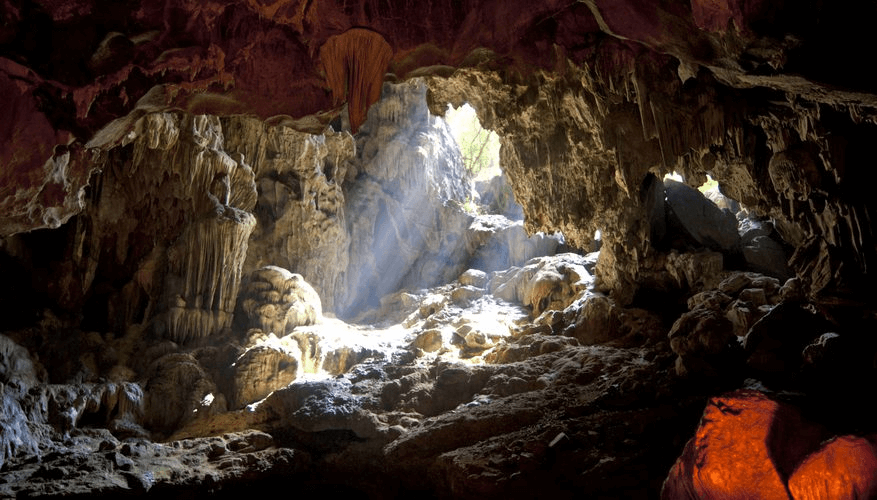
70+ Cave Features For Fantasy Worldbuilding36 min read
Stalactites, stalagmites, caverns, and crystals! Welcome back, Outlander, to the 12th entry in Mythic Ecology, my series on how learning real-world landscape features can enrich our fantasy worldbuilding and storytelling. In this post I return to my minimalist framework for Dungeon Masters, Game Masters, fiction writers, and similar worldbuilders to merge the realms of general myth and geomorphology. Last entry I took a detour to update my D&D 5e Free Resource Compendium. As I resume my journey sketching a framework for designing Yridia, my unique D&D 5e fantasy world, let’s learn some cave terms, with a visual guide!
All the images herein I use for educational and entertainment purposes, I claim no rights to any of them. For corrections or content removal requests, hit my contact page. Special thanks go to Jim Belt of Start Caving for “Types of Cave Passages: Advanced Illustrated Guide“, a vital resource for this entry.
Part 0: Mythic Ecology For Fantasy Worldbuilding & Storytelling
-Settlements
-Omens
-Overlooks
-Passageways
-Abyss
-Battlegrounds
Part 1: Caves 101
–Cave
-Cavern
-Grotto
Part 2: Cave Ecologies
–Endogean (Entrance Zone)
–Parahypogean (Twilight Zone)
–Hypogean (Dark Zone)
–Deep Hypogean (Underdark Zone)
Part 3: Cave Form Categories
–Anchialine Caves
–Corrasional Caves / Erosional Caves
–Fracture Caves
–Glacial Cave
–Primary Caves
-Rock Shelters
-Sea Caves / Littoral Caves
-Solutional Caves / Karst Caves
-Talus Caves
Part 4: Cave Passage Patterns I
–Anastomotic Caves
–Angular Network Caves
–Branchwork Caves
–Pit Caves
-Ramiform Caves
-Spongework Caves
Part 5: Cave Passage Patterns II
–Phreatic Passages
—Avens / Bell Holes
—Soluble Bed
–Sump
-Vadose Passages
–Keyhole Passages
–Drain Shaft
–Breakout Chamber / Dome
-Epiphreatic Passages
–Intertidal Passages
-Fault-Formed Passages
-Fissure/Rift Passages
Part 6: Dripstone Speleothems
–Speleothems
—Dripstones
—Stalactites
—-Chandeliers
—-Helictites
—-Soda Straws
—Stalagmites
—-Broomstick Stalagmites
—-Fried Egg Stalagmites
—-Totem Pole Stalagmites
—Stalagnates / Columns
Part 7: Flowstone Speleothems
—Flowstones
—Draperies
—Rimstone Dams / Gours
—Stone Waterfalls
Part 8: Crystal Speleothems
–-Cave Crystals
—Anthodites
—Cryogenic Calcite Crystals
—Dogtooth Spar
—Frostwork
—Moonmilk
Part 9: Speleogens & Exotics
–Speleogens
—Boneyard
—Boxwork
—Pillars
–Scallops
-Exotics
–Calcite Rafts
–Cave Peals
–Cave Popcorn / Coralloids / Cave Coral
–Hells Bells
–Stottites / Snoticles
Part 10: Pits & Shafts
–Abime / Pit Caves / Pot Caves / Shaft Cave / Jama
–Blowhole
–Cenote
–Foiba
–Karst Fenster
-Moulin / Glacier Mill
-Panhole / Weathering Pans
-Scowle
-Sinkhole
Part 11: Special Cave Features
–Boulder Choke
–Cave In
–Cave Window
-Sunholes
-Subterranean Tunnel
-Subterranean Waterfall
PART 0: MYTHIC ECOLOGY FOR FANTASY WORLDBUILDING & STORYTELLING
Let’s revisit my minimalist framework for my worldbuilding. The six archetype tags with which I will flag all the various real-world land features in my Mythic Ecology Series:
1. Settlements: habitable regions of either Work or Play, Familiar or Exotic, offering diverse narrative functions: a Day in the Life, Home Base, Personal Reasons, Gathering Supplies. Can subvert tropes with Ruins or Escape.
2. Omens: sensational, temporal, or particularly pointed features that offer narrative functions of forshadowing, and good or evil portents. Can subvert tropes with a Wild Goose Chase.
3. Overlooks: sites of magnitude and grandeur, living monuments which can function narratively for finding resolve, invoking spirits, or as a Call to Adventure. Can subvert tropes with Dread or Betrayal.
4. Passageways: transitional journeylands, including magical portals, functioning narratively for initiation and return, thresholds and tests, shortcuts and setbacks.
5. Abyss: a void or confined space presenting scarcity or temptation, desperation and danger. Can subvert tropes with a Timely Rescue or Secret Refuge.
6. Battlegrounds: sites fit for epic, sprawling encounters and climax conflicts. Can subvert tropes with Alternative Solutions.
Feel free to submit your own ideas, or draw outside the lines. Alright, let’s see how caves fit in.
PART 1: CAVES 101

- Cave – a natural underground space large enough for a person to enter.
[Settlements, Omens, Overlooks, Passageways, Abyss, Battlegrounds]

- Cavern – a cave chamber.
[Settlements, Omens, Passageways, Abyss]

- Grotto – an inhabitable natural or artificial cave, often near water, and sometimes partially flooded.
[Settlements, Omens, Overlooks, Passageways, Abyss, Battlegrounds]
PART 2: CAVE ECOLOGIES

Endogean (Entrance Zone) – the parts of caves interacting with surface soils through cracks and rock seams, groundwater seepage, and root protrusion.
[Settlements, Omens, Passageways, Abyss, Battlegrounds]

Parahypogean (Twilight Zone) – the threshold portions near cave mouths extending to the last penetration of sunlight.
[Settlements, Omens, Overlooks, Passageways, Abyss]

Hypogean (Dark Zone) – “true” cave environments, can have regular contact with the surface via wind and underground rivers, animal migration, or almost entirely isolation.
[Settlements, Omens, Passageways, Abyss]

Deep Hypogean (Underdark Zone) – can host autonomous ecologies whose primary energy sources comes from chemical energy harvested by bacteria from minerals like limestone, rather than from sunlight. In D&D mythos this could correspond to the “Underdark”.
[Settlements, Omens, Overlooks, Passageways, Abyss, Battlegrounds]
PART 3: CAVE FORM CATEGORIES

Anchialine Caves – caves formed in mixtures of freshwater and saline water, usually coastal. Frequently signifies underwater caverns.
[Settlements, Omens, Overlooks, Passageways, Abyss, Battlegrounds]

Corrasional Caves / Erosional Caves – caves formed entirely by erosion from flowing streams carrying rocks of any kind, and sediment, along a fault or joint. Also includes aeolian caves carved by wind-born sediment. Often erosion expands smaller openings arising from solutional processes.
[Settlements, Omens, Passageways, Abyss]

Fracture Caves – caves formed when layers of more soluble minerals, like gypsum, dissolve away between layers of less soluble rock, causing fractures and collapses in blocks of stone.
[Settlements, Omens, Passageways, Abyss]

Glacial Cave – caves formed within glacial ice. Related to moulin.
[Omens, Passageways, Abyss]

Primary Caves – caves formed from the same surrounding rock. This includes lava tubes arising as lava solidifies and hollows beneath the crust, as well as blister caves, tufa caves, and reef caves.
[Settlements, Omens, Passageways, Abyss]

Rock Shelters – simple, often shallow cave-like openings at the base of a bluff or cliff. Produced by bedrock erosion in insoluble rock, such as where sandstone overlies shale. Whereas normal caves have more depth than width, rock shelters have more width than depth.
[Settlements, Passageways, Abyss]

Sea Caves / Littoral Caves – caves formed primarily by erosion from the sea’s wave action; they may form along present coastlines or remain on former coastlines.
[Passageways, Abyss]

Solutional Caves / Karst Caves – caves formed in soluble rock, typically limestone, but sometimes also chalk, dolomite, marble, salt, or gypsum. Formed as natural acid in groundwater seeps through bedding plans, faults, or joints, and dissolves open cracks which become caves. The most common cave type.
[Settlements, Omens, Passageways, Abyss]

Talus Caves – caves formed by openings among random heaps of large, fallen boulders, often at the base of cliffs. Related to scree.
[Settlements, Omens, Passageways, Abyss]
PART 4: CAVE PASSAGE PATTERNS I


Anastomotic Caves – passages separating then meeting further down drainage, resembling braided streams. Typically formed along one bed or structure, rarely crossing into upper or lower.
[Omens, Passageways, Abyss]

Angular Network Caves – high, narrow, straight passages persisting in widespread closed loops. Formed from intersecting fissures of carbonate rock with fractures expanded by chemical erosion.
[Omens, Passageways, Abyss]
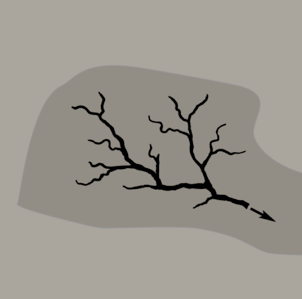
Branchwork Caves – passages converging downstream as tributaries, resembling dendritic streams. Most common cave passage form, associated with sinkholes; each branch has a separate recharge source.
[Omens, Passageways, Abyss]

Pit Caves – passages appearing as vertical shafts, such as vertical caves, potholes, or pits, rather than horizontal passages. May or may not be associated with other structural patterns.
[Omens, Overlooks, Passageways, Abyss]

Ramiform Caves – passages forming as randomized three-dimensional rooms resembling irregular large rooms and galleries. Formed when a rising water table erodes carbonate rock with hydrogen-sulfide enriched water.
[Settlements, Omens, Passageways, Abyss, Battlegrounds]

Spongework Caves – passages manifesting in a random three-dimensional pattern, resembling a sponge. Formed when solution cavities mix with chemically diverse water.
[Settlements, Omens, Passageways, Abyss, Battlegrounds]
PART 5: CAVE PASSAGE PATTERNS II
Phreatic Passages – passages in the zone of underground water, saturated beneath the water table.


Avens / Bell Holes – vertical tubes in a cave ceiling formed by water swirling under extreme pressure.
[Omens, Overlooks, Passageways, Abyss]

Soluble Bed – formed when water dissolves carbonarite rock then the water table drops, leaving a wide and low space with smooth ceiling and floor.
[Omens, Passageways, Abyss]
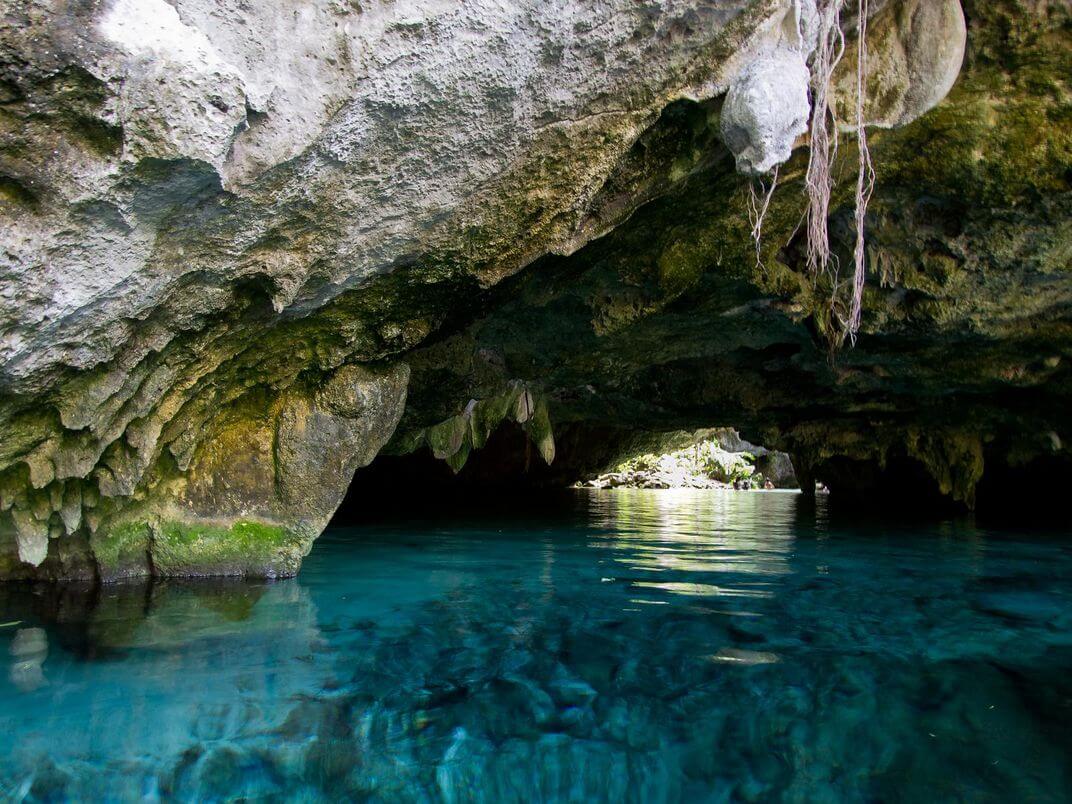
Sump – a cave passage submerged in water, with either static or active flow.
[Omens, Passageways, Abyss]
- Vadose Passages – passages in the zone above the water table, comprising a cave drain complex. Formed by free-flowing water, which creates channels like shafts and canyons. Narrow passages indicate rapid incision, whereas wide ones indicate stable water levels.


- Keyhole Passages – keyhole-shaped passages carved out by streams, sometimes too narrow to navigate.
[Omens, Passageways, Abyss]

- Drain Shaft – vertical, straight, and narrow shafts, sometimes large, that can connect horizontal passages on different levels, carved out as water trickles along break lines and fractures.
[Omens, Overlooks, Passageways, Abyss]

- Breakout Chamber / Dome – passages formed by the collapsed ceilings of phreatic tubes, with telltale floors and sometimes vault-like shapes at the top.
[Omens, Passageways, Abyss]
- Epiphreatic Passages – the floodwater zone between the phreatic and vadose zones, flooded during high water and drained during low water, containing either water under pressure and free-flowing water depending on the cycle.

- Intertidal Passages – passages formed as water floods in and out of the cave.
[Omens, Passageways, Abyss]

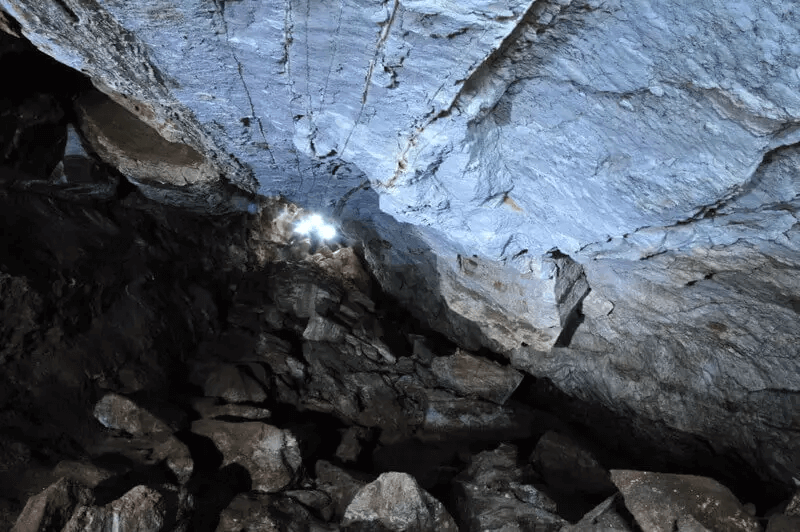
- Fault-Formed Passages – passages with large stretches of straight rock formed by seismic activity, indicated by planar hanging walls of split rock.
[Omens, Passageways, Abyss]

- Fissure/Rift Passages – straight and narrow passages more deep than wide. Started as rock splits or cracks then develops along the joint, wearing out and widening. Come in both phreatic (pressurized) and vadose (slow erosion) forms.
[Omens, Passageways, Abyss]
PART 6: DRIPSTONE SPELEOTHEMS

- Speleothems – cave formations created by gradual accretion of secondary minerals into deposits, typically in limestone or dolomite solutional caves. Usually a translucent white color from calcium carbonate.
- Dripstones – calcium carbonate structures. Includes stalactites, stalagmites, and stalagnates.

- Stalactites – pointed pendants growing down from cave ceilings, typically conical.
- [Omens]

- Chandeliers – complex clusters of decorative ceiling stalactites.
[Omens]

Helictites – stalactites with a central canal with twig-like or spiral projections that seemingly defy gravity. Includes ribbon helictites, saws, rods, butterflies, hands, curly-fries, “clumps of worms”.
[Omens]

- Soda Straws – very thin but long stalactites with an elongated cylindrical shape.
[Omens]

- Stalagmites – the upward protrusion counterparts of stalactites, often blunt mounds.
[Omens]

- Broomstick Stalagmites – very tall and spindly stalagmites.
[Omens]
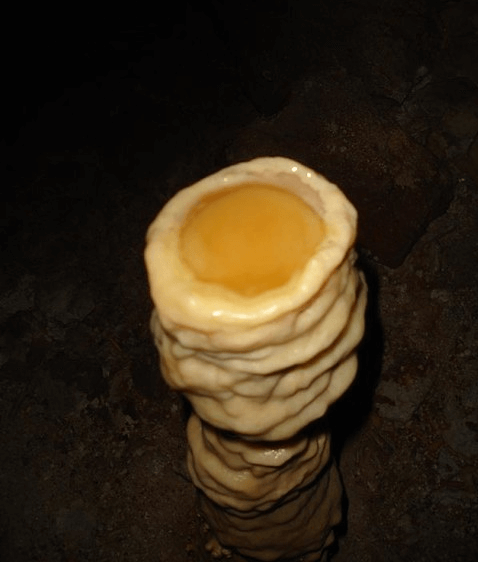
- Fried Egg Stalagmites – small, typically wider than tall.
[Omens]

- Totem Pole Stalagmites – tall and shaped like totem poles.
[Omens]

- Stalagnates / Columns – pillars formed when stalactites meet stalagmites, or stalactites reach the cave floor.
[Omens]
PART 7: FLOWSTONE SPELEOTHEMS
- Flowstones – sheet-like structures found on cave floors and walls.

- Draperies – wavy sheets of calcite hanging downward, resembling thin curtains. Includes “bacon”, with colorful bands within sheets.
[Omens]

- Rimstone Dams / Gours – barriers, possibly containing water, which occur at stream ripples.
[Omens, Abyss]
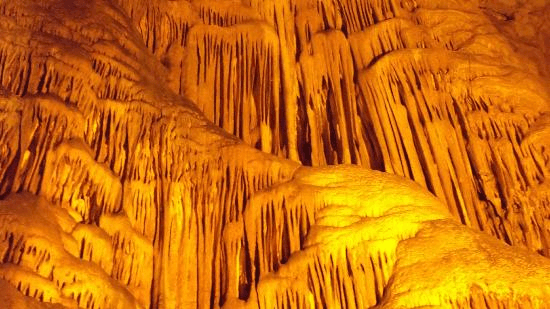
- Stone Waterfalls – formations simulating frozen cascades.
[Omens]
PART 8: CRYSTAL SPELEOTHEMS
- Cave Crystals – crystalline structures found in caves.

- Anthodites – flower-like clusters of aragonite crystals.
[Omens]

- Cryogenic Calcite Crystals – loose grains of calcite found on cave floors, formed by segregation of solutes as water freezes.
[Omens]

- Dogtooth Spar – large calcite crystals often found near seasonal pools.
[Omens]

- Frostwork – needle-like growths of calcite or aragonite.
[Omens]

- Moonmilk – a white, creamy substance found inside limestone caves.
[Omens]
PART 9: SPELEOGENS & EXOTICS
- Speleogens – cave formations created by erosion via the removal of bedrock, rather than as secondary deposits. Can have various colorations from chemicals like iron oxide, copper, or manganese oxide, or sometimes brown from mud or silt.

- Boneyard – an intricate maze of limestone with many holes, where material has dissolved away.
[Omens, Passageways, Abyss]

- Boxwork – speleogens formed when bedrock between preexisting calcite veins weathers away preferentially during cave development.
[Omens]

- Pillars – speleogen columns formed by gradual erosion of softer rock like sandstone, rather than deposition.
[Omens]

- Scallops – small, asymmetrical, scoop-like depressions of variable size and reflective of longterm water flow patterns.
[Omens]
- Exotics – miscellaneous rare speleogen phenomena.

- Calcite Rafts – thin accumulations of calcite that appear on cave pool surfaces.
[Omens]

- Cave Pearls – small “seed” crystals resulting from water dropping high above, forming near-perfect spheres of calcium carbonate.
[Omens]

- Cave Popcorn / Coralloids / Cave Coral – small, knobby clusters of calcite, aragonite, or gypsum.
[Omens]

- Hells Bells – submerged, bell-like shapes.
[Omens]

- Snottites / Snoticles – colonies of predominantly sulfur-oxidizing bacteria having the consistency of snot.
[Omens]
PART 10: PITS & SHAFTS

- Abime / Pit Caves / Pot Caves / Shaft Cave / Jama – a vertical shaft in karst terrain, sometimes very deep, usually opening into a network of subterranean passages.
[Omens, Overlooks, Passageways, Abyss, Battlegrounds]

- Blowhole – a hole in a sea cliff or coastal terrace through which columns of spray jet upward loudly. Most likely to occur along fault lines or on islands, where waves concentrate and release in coastal rock crevices.
[Omens, Passageways, Abyss]

- Cenote – a natural pit or sinkhole that exposes groundwater underneath as limestone bedrock collapses. Culturally associated with locations for sacrificial offerings.
[Omens, Overlooks, Passageways, Abyss]

- Foiba – an especially deep natural sinkhole comprised of a collapsed portion of bedrock above a void. Water erosion gradually excavates chasms into the shape of an inverted funnel.
[Omens, Overlooks, Passageways, Abyss]

- Karst Fenster – an unroofed portion of a cavern which reveals part of a subterranean river.
[Settlements, Omens, Overlooks, Passageways, Abyss]

- Moulin / Glacier Mill – a roughly circular, vertical well-like shaft within a glacier or ice sheet which surface water enters.
[Omens, Overlooks, Passageways, Abyss, Battlegrounds]
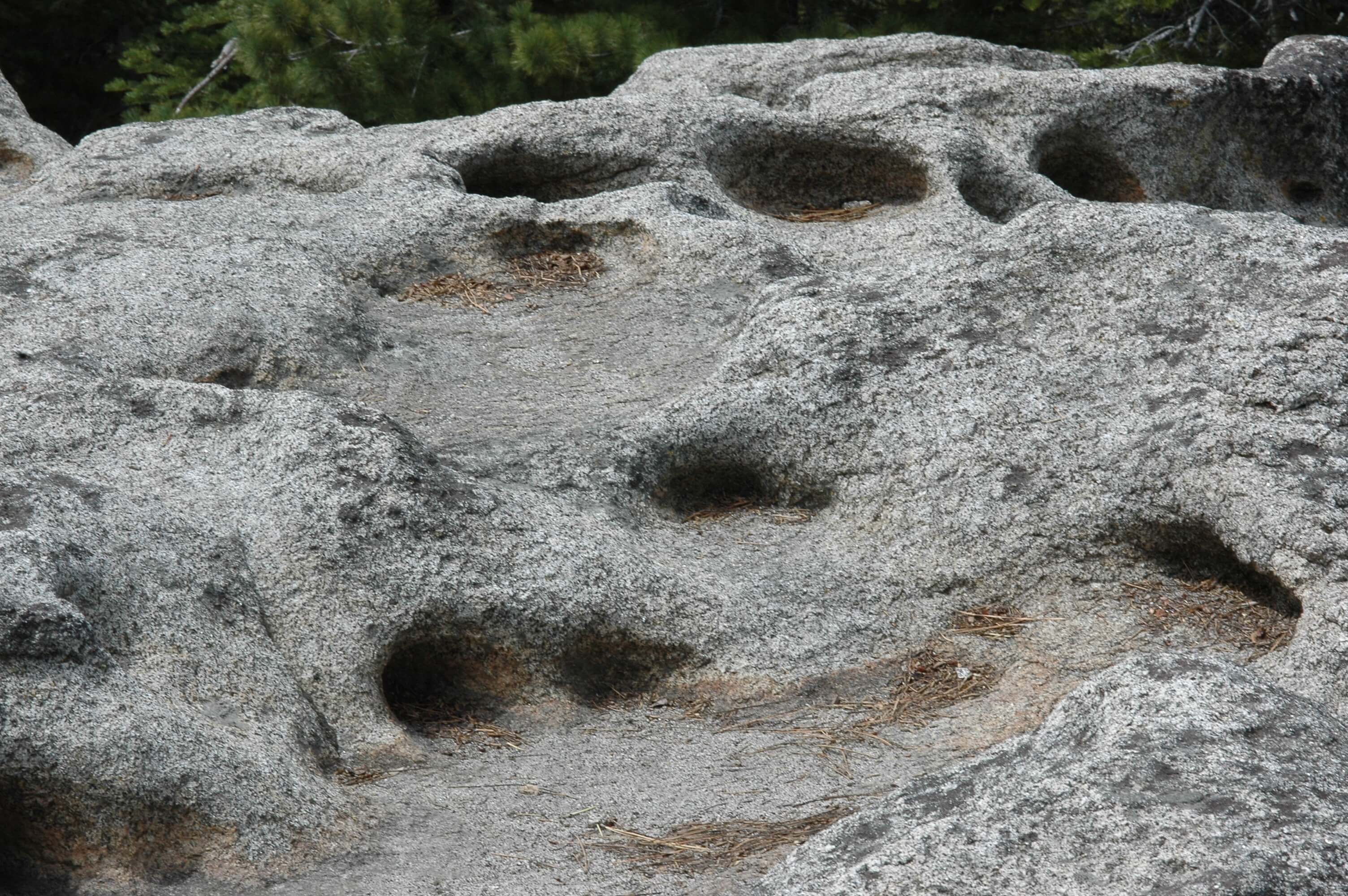
- Panhole / Weathering Pans – a shallow depression or basin eroded into flat or gently sloping cohesive rock, sometimes found in deserts.
[Settlements, Omens, Passageways, Abyss]

- Scowle – features ranging from amorphous shallow pits to irregular labyrinthine hollows.
[Settlements, Omens, Passageways, Abyss]

- Sinkhole – a depression or hole in the ground caused by a surface collapsing into an existing void.
[Omens, Overlooks, Passageways, Abyss]
PART 11: SPECIAL CAVE FEATURES
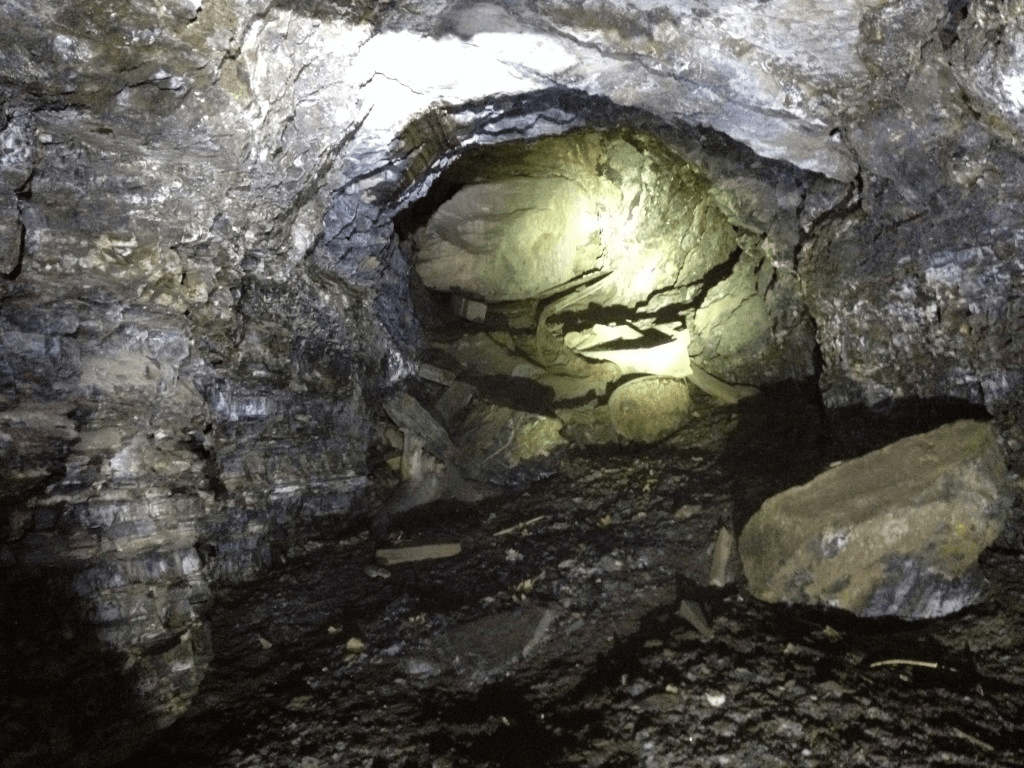
Boulder Choke – a collection of large rocks or rubble that obstructs the passage of a cave.
[Omens, Passageways, Abyss]
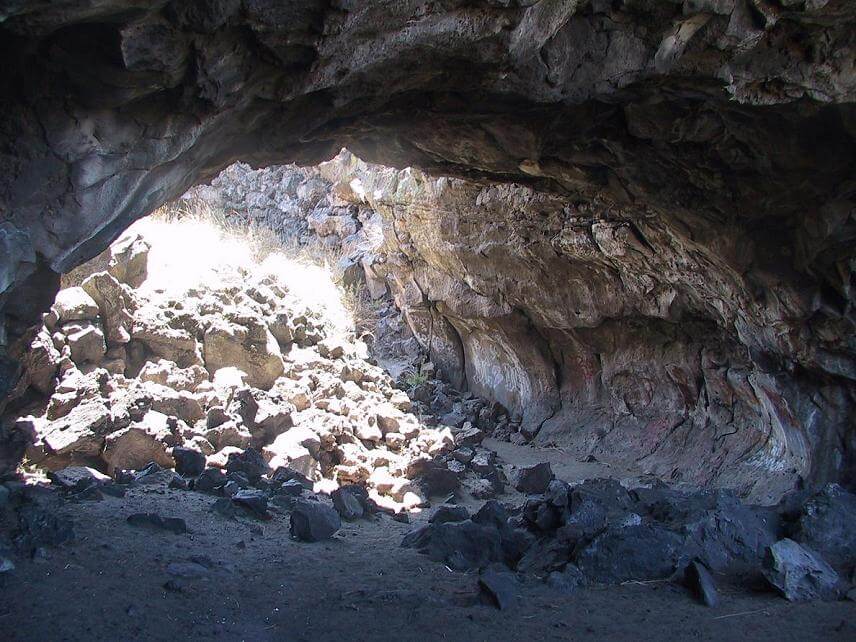
Cave In – a partial or total collapse of a cave structure, potentially opening new passages or blocking old ones. Glacial formations prove extra susceptible.
[Omens, Passageways, Abyss, Battlegrounds]

Cave Window – a hole in a thin wall that connects two chambers or passages, or that exposes the outside of the cave.
[Omens, Overlooks, Passageways]
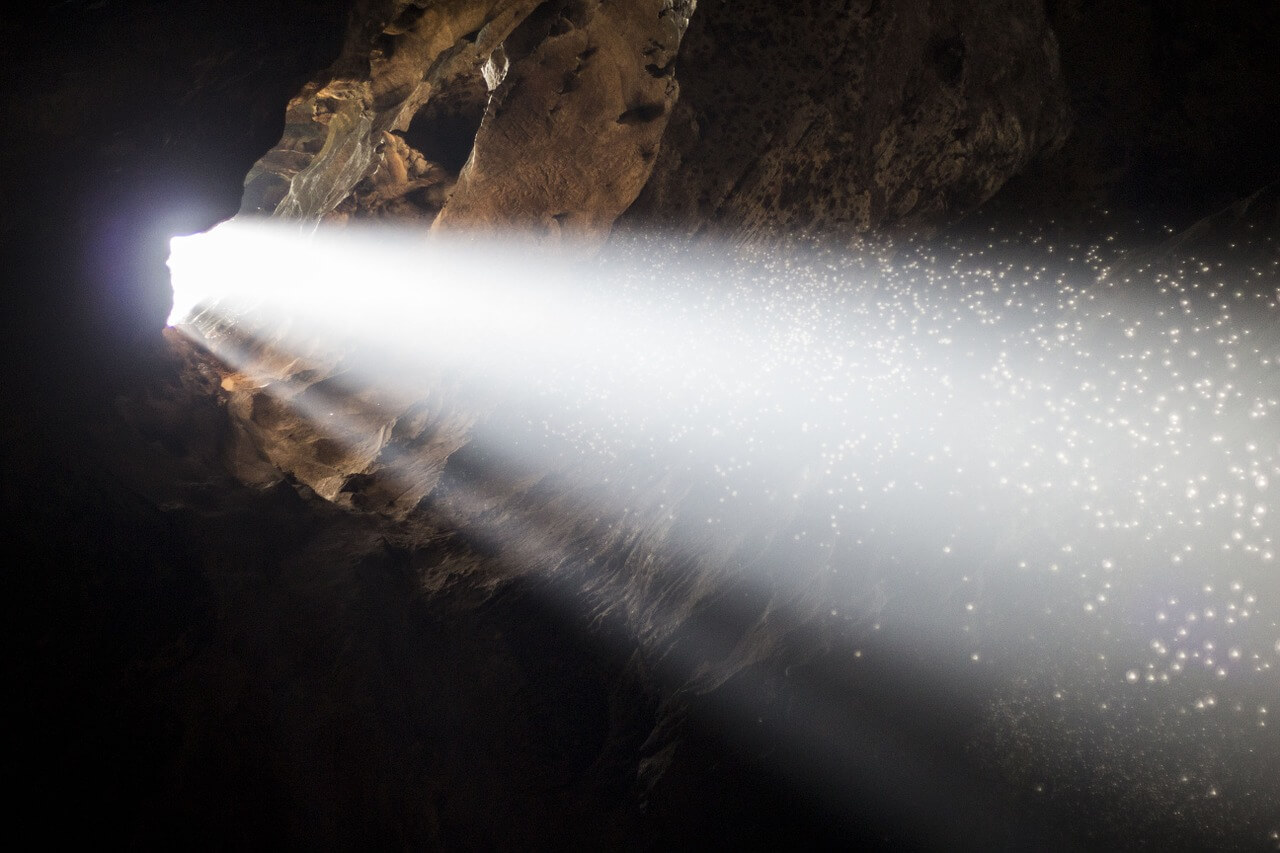
Sunholes – a hole in a cave roof which lets in sunlight and air.
[Omens, Overlooks, Passageways]

Subterranean Tunnel – in certain soil and rock conditions, underground tunnels can form which can function as passageways.
[Omens, Passageways, Abyss]

- Subterranean Waterfall – a waterfall located underground, common where vertical drop-offs occur in caves.
[Omens, Overlooks, Passageways, Abyss]
FINAL THOUGHTS
I hope you enjoyed this twelfth entry in my Mythic Ecology series! I look forward to continuing with it, I have some greater ambitions for developing this series into worldbuilding web tools. Give this a share if you liked it, and let me know in the comments if you have any feedback. I publish new posts on alternating Tuesdays. In the meantime, I post original D&D memes and writing updates over on my site’s Facebook Page. Also, if you want to keep up-to-date on all my posts, check out my Newsletter Sign-Up to receive email notifications when I release new posts. A big thanks as always to my Patrons on Patreon, helping keep this project going: Adam, Alexander, Anthony, Benjamin, Chris, Eric & Jones, Evan, Geoff, Jason, Rudy, and Tom. Thanks for your support!






[…] Overview & Sub-Types Natural cavern complexes (which I’ve explored at length elsewhere), as well as artificial underground paths like tunnels and sewers, and even excavation […]
This is so so fantastic and helpful! I’m so glad I stumbled across your site. 😀 Thank you!